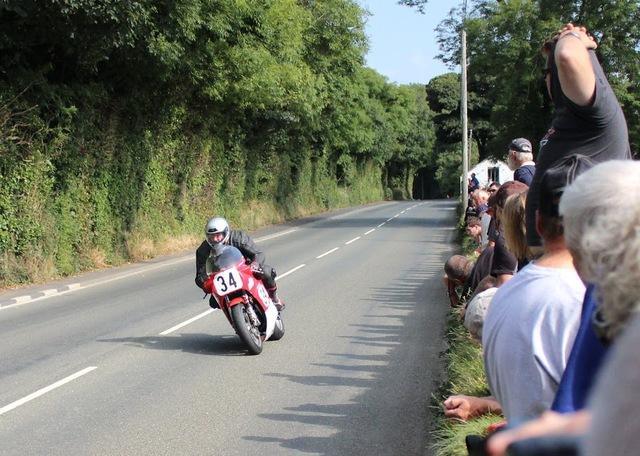-
Posts
388 -
Joined
-
Last visited
Content Type
Profiles
Forums
Events
Posts posted by canamant
-
-
I agree ! gear train ratios are similar on both engines as is final drive. Wheel size accounts for 4 or 5% so the top speed should have been 15% higher on short strokes.
-
5200 feet per minute mean piston speed will end in tears. That, plus the weight of the 100 piston compared to the 750 one will give the rod a really hard time at the top of the exhaust stroke. One thing I have noted is that the short stroke 750s might not rev as hard as the tacho suggests. I've run longstroke 750 race bikes on standard ignition systems to the revlimiter using 11000 12000 and 13000 rpm tachos and they all passed the redline before the revlimiter cut in.
-
oops - forgot about the top plate. Bloody comfortable bikes.
-
No FBOB. The forks will be flush with the top of the yoke so the over all length will be 785mm
-
Brief update. This year's racing has been a bit of a flop to say the least with only 2 outings at Aintree because of family illness and other problems, and of the 2 rounds I did do, I had my first ever mechanical failure in 15 years when the gear lever broke in the final. Sometimes the Gods are trying to tell you something and you have to listen :-)
1100 slabby racer has also hit a few problems in the engine dept. "New" cylinders were cracked so the hunt was on for replacements - thanks to YJ for the 1216 set, and the crankcases turned out to be damaged. Thanks to Creg Ny Baa for replacements also. At least I've got the engine from the 2012 MGP 750 motor built up again and the 2013/2016 MGP 860 engine has been rebuilt with new crankcases and gearbox following it breaking up the gearbox bearings accelerating out of pit lane at the Manx. It means that next year we will have the two 860s and two 1100s to choose from. Roll on winter.
-
 3
3
-
-
Bin them.
-
All cams (apart from shim adjustment ones) will fit all oil cooled engines in theory. However fitting higher lift cams in some engines can either make the springs go coilbound or the upper retainer/collets hit the valve guide. I had an 1100F/Powerscreen engine fitted with 750 J/K cams which was supposed to be good. When I stripped it to check it out there was almost no clearance between the collets and guides and the inlet cams were coilbound at full lift. You need to decide if you really need to change the cams and if you do change them then do the measurements - cam timing, valve to piston, collet to valve guide.
-
 4
4
-
-
That doesn't sound too far off. GS750s were about 70 at 4800 to 5000 depending on tyre (120/90 18 or 4.25/85 18. I seem to remember 1000s were about 17mph/1000 rpm. I'm going back 35 years now so can't be that precise.
-
-
That ignition rotor only locates on the crank via the pin. I'd be wary of swinging on it. As above - only solution is to take head off and put penetrating oil in cylinders for a few days.
-
No. The "dogbones" are part of slabby swingarms. As above, R1/R6 unit on slabby 750 swingarm or let the swingarm sag without unit in place, measure swingarm eye to frame mount eye, and get custom unit built by Hagon. I did the custom approach on slabby 11.
-
If you do use 1100F cams make sure there is sufficient valve collet to valve guide clearance. It is close on the inlet - not sure about the exhaust though.
-
-
Oh Dear Garry. Heal fast.
-
Any news on team mean bean ?
-
I took 50 thou (1.25mm) off an 1100F head with B12 pistons to fit following careful measurement on a dirty build. You really need to build it up with the old gaskets, time it properly and then do a valve to piston measurementon the inlet at 2 degree intervals from TDC forwards and from about 20 degree BTDC on the exhaust. The valve to piston clearance will get smaller then bigger as you go. Then you decide what clearances you can live with and skim accordingly, how close you want to go depends on the use of the engine and the type of rider who will be using it.
If it is just to remove a few marks then there should be enough leeway to get them out. Or skim the thicknes of the base gasket and fit a 2nd base gasket for peace of mind if you don't want to do the measuring ?
-
I used the bobbins solution but bolted them to a piece of ally bar which I pinched with the fairing bracket mounting bolt on each side.
-
Wider type chain ?
-
John
As been said, slotting sprockets is easy. Get a small round file (chainsaw file will be about right) and file the holes out. Remember that 10 degrees at the crank is only 5 degrees at the cam. You will find that you don't need to remove much metal, a file is cheaper than new sprockets, and you get to keep the file after you have done the job !
If you need more encouragement later on we are all here to help.
-
 1
1
-
-
Using the 750 cams shouldn't do any harm at all. I'm not certain but I would expect the camshaft sprockets on short stroke 750s and 1127s to have the bolt holes in the same places. Make sure you orientate the cams correctly on the sprockets. I'm assuming you know what sprocket marks to set up to and the number of pins between the exhaust and inlet cam marks. Set up according to the book. If you you don't have a dial gauge (you really really should get one - they cost peanuts) you can do a very rough valve to piston check by turning the engine over a few degrees at a time from TDC and checking the inlet valve which is just starting to open (which will be on cylinder 1 or 4) push the rocker down with a lever until the valves touch the piston. As you go past TDC the piston will get closer to the inlet valve. When you push the valve down, try and get a feeler gauge between the cam and the rocker. A friend might be useful at this point. The rocker ratio is 1.5 to 1 so if you have a 40 thou gap at the cam you have a 60 thou clearance at the valve. Closest approach should be about 10 deg ATDC but run the check from TDC to about 20 degrees after. Inlet limit is 1mm or 40 thou at the valve or 27 thou at the cam. if you get this clearance then take the engine to BDC and then raise it up towards TDC again. One exhaust valve will now be almost closing with the piston approaching it. Again have an assistant push the rocker/valve down with a lever and measure the rocker/cam clearance with a feeler gauge. Closest approach on exhaust is 80 thou so you should be able to fit a 54 thou feeler gauge between the cam and the rocker at closest approach.
With each of the measurements, you don't need to measure the gap, just make sure the 27 thou and 54 thou gauge will fit at every increment.
It will be easier if you print off a degree disc from the interweb and stick it to an old CD and bolt it to the ignition rotor. You can fit a pointer from the clutch cover bolt. Turn the engine with a slim open ended spanner on the rotor.
This method is not ideal but might give you some idea of how close the valves are getting to the pistons and whether you are heading for trouble. It is vital that you get the first inlet measurement on the first few degrees from TDC and only if that gives some clearance go to the exhaust measurement on the next BTDC.
Take it easy and slowly, feeling for any resistance.
Good luck.
-
 2
2
-
-
-
I'd do it right by slotting the sprockets. Retarding the inlet by one tooth won't give valve to piston issues but it will move the crossover point to the right of TDC most probabaly and will reduce the overlap. If you have had to open the valve clearances to 15 thou (from 6 thou?) to stop it going stiff then the valve to piston clearance is only 7 or 8 thou. Such a set up won't last 5 minutes.
I've been doing the same with a powerscreen engine with a heavily skimmed head and trying lots of different cams. Powerscreen cams have close running clearances at standard. There are no quick fixes when swapping heads and cams about. I have spent many many hours doing graph after graph on my engines to select the correct cam and timings.
-
 2
2
-
-
Thanks for the tip Funky Monk. I'll give it a whirl and see.
-
Thanks for looking Swirl
-
 1
1
-




Cams n stuff
in Oil Cooled
Posted
What was the standard lift at the valve ?
Check several things.
First, will the springs go coilbound with the additional lift ?
Second, is there sufficient clearance between the valve collets/upper spring retainer and the valve guide ?
What will the valve to piston clearance be at the valve timing you want to use? You might not be able to use the timing you want unless you pocket the pistons.
Valve springs need to be strong enough to keep the valve in contact with the cam when closing. It depends on the cam profile as well as the lift and how hard you are revving it. Sorry I can't be of more help.